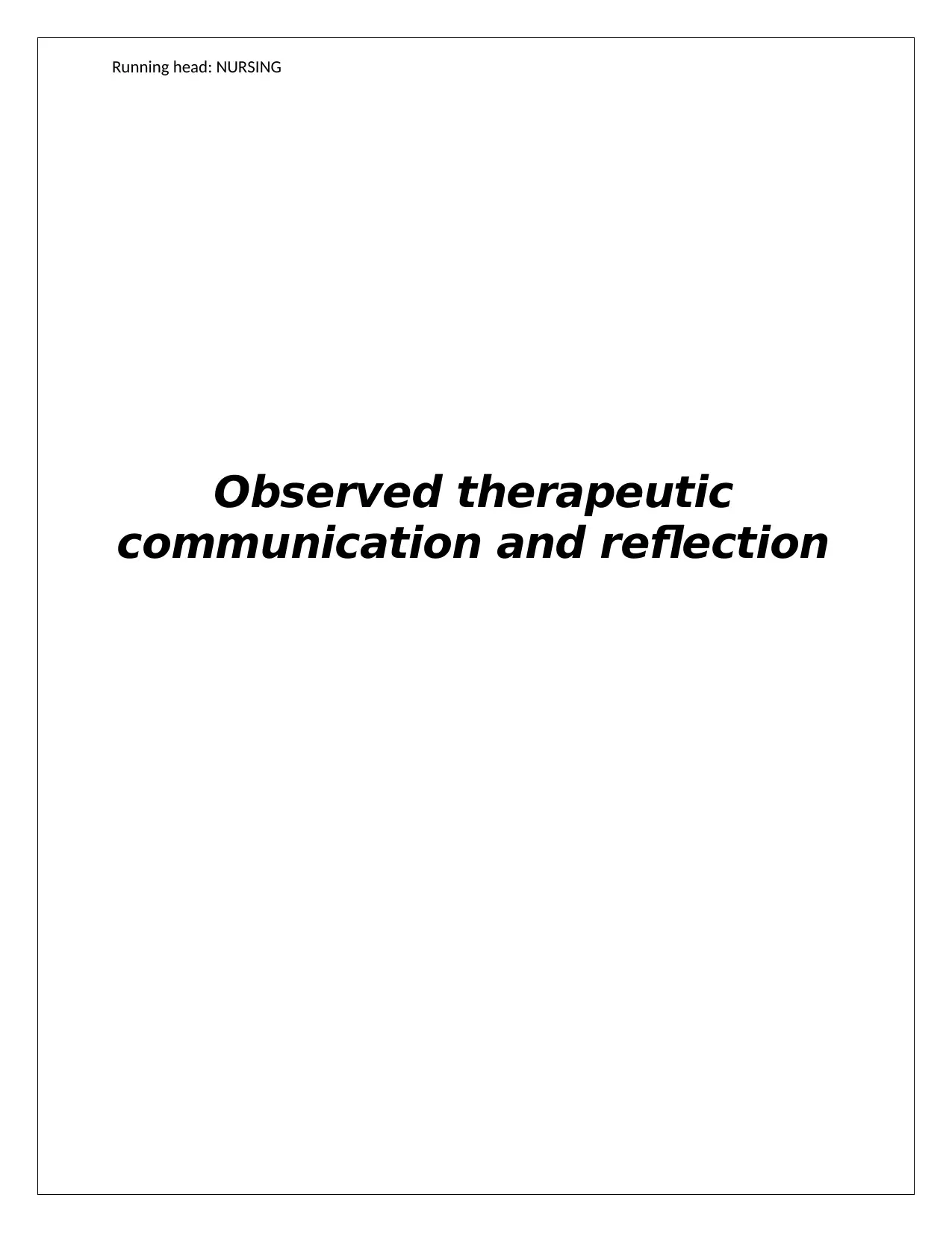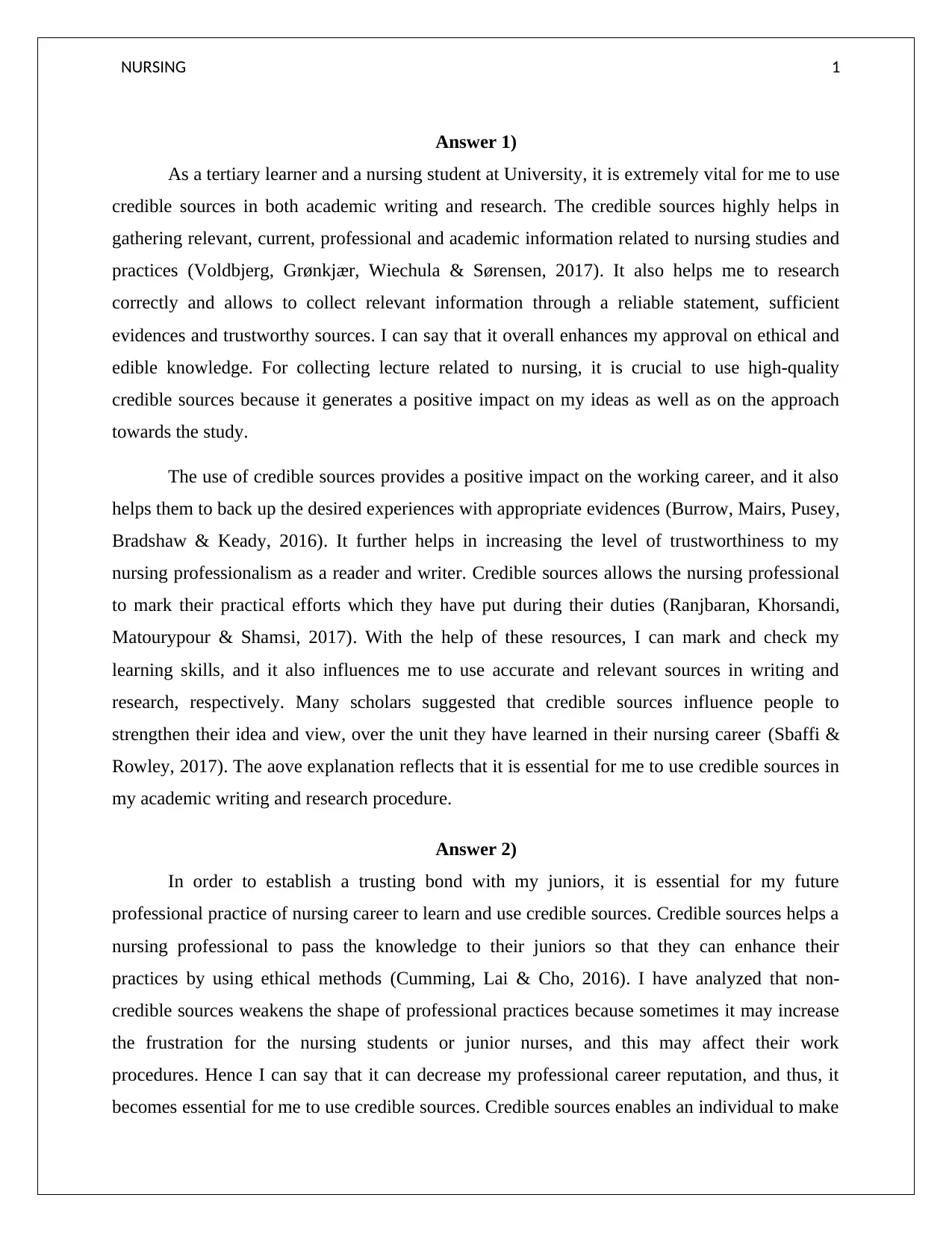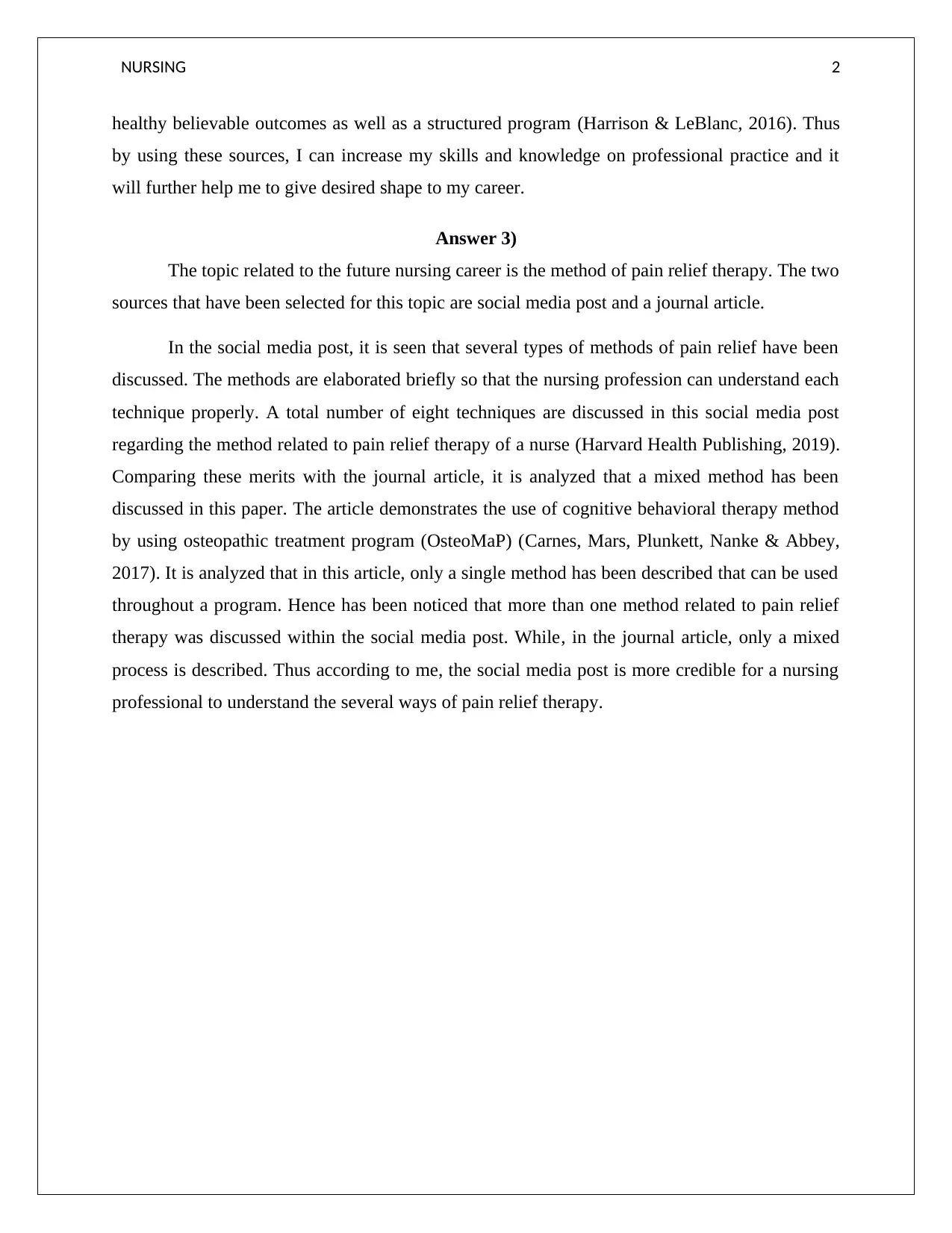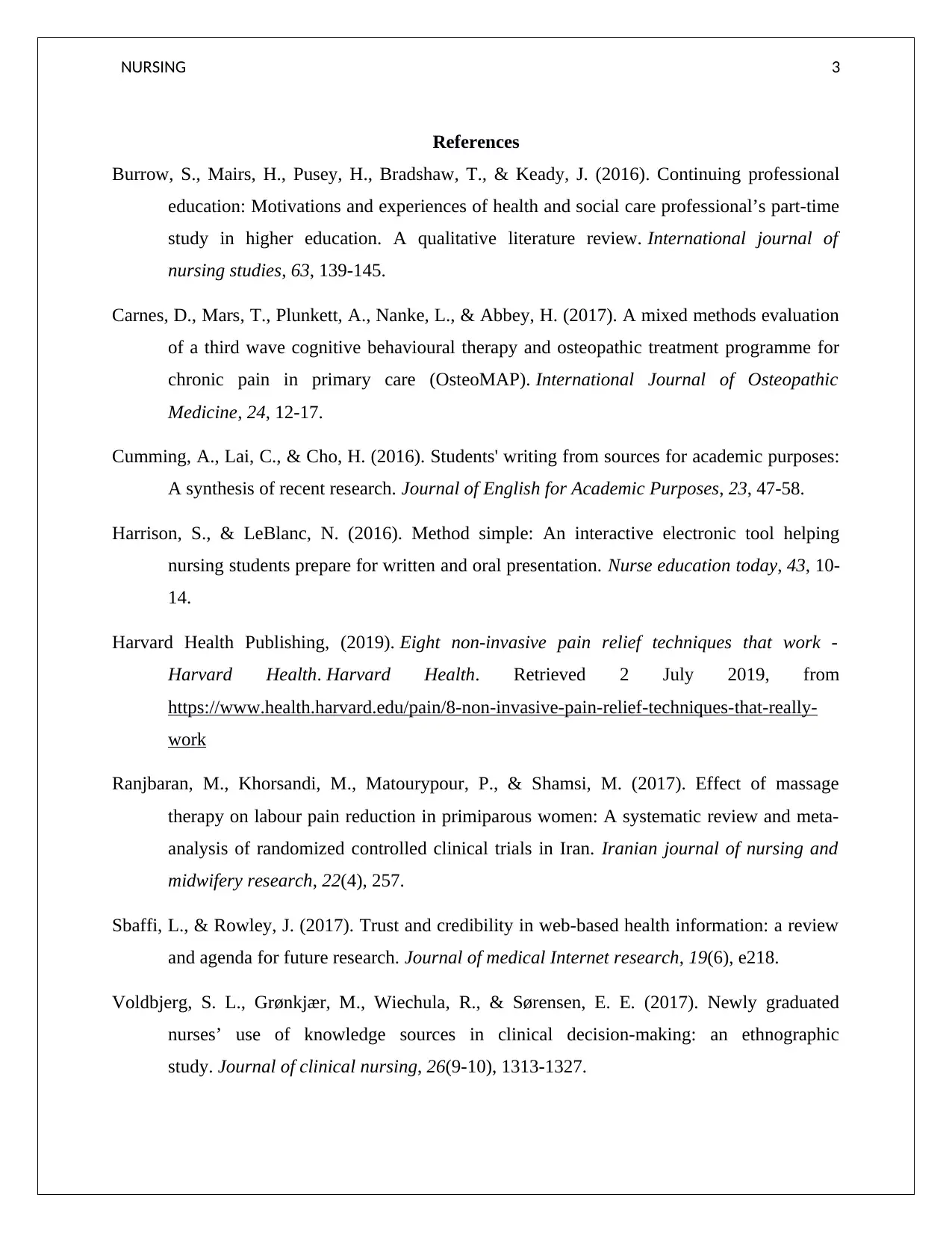NURSING 3: Exploring Credible Sources in Nursing Practice and Research
VerifiedAdded on 2022/11/26
|4
|1138
|173
Homework Assignment
AI Summary
This assignment, completed by a nursing student, emphasizes the crucial role of credible sources in academic writing and research within the nursing field. The student highlights the importance of using reliable sources for gathering current, professional, and academic information, which aids in ethical and informed decision-making. The assignment addresses the impact of credible sources on professional practice, particularly in establishing trust with colleagues and providing accurate knowledge to junior nurses. It analyzes two sources—a social media post and a journal article—related to pain relief therapy, comparing their credibility and the breadth of methods discussed. The student concludes that credible sources are essential for enhancing learning skills and influencing the use of accurate and relevant information in both writing and research, ultimately strengthening their approach to nursing studies and practices. References from various scholars and publications are provided to support the arguments made.

Running head: NURSING
Observed therapeutic
communication and reflection
Observed therapeutic
communication and reflection
Paraphrase This Document
Need a fresh take? Get an instant paraphrase of this document with our AI Paraphraser

NURSING 1
Answer 1)
As a tertiary learner and a nursing student at University, it is extremely vital for me to use
credible sources in both academic writing and research. The credible sources highly helps in
gathering relevant, current, professional and academic information related to nursing studies and
practices (Voldbjerg, Grønkjær, Wiechula & Sørensen, 2017). It also helps me to research
correctly and allows to collect relevant information through a reliable statement, sufficient
evidences and trustworthy sources. I can say that it overall enhances my approval on ethical and
edible knowledge. For collecting lecture related to nursing, it is crucial to use high-quality
credible sources because it generates a positive impact on my ideas as well as on the approach
towards the study.
The use of credible sources provides a positive impact on the working career, and it also
helps them to back up the desired experiences with appropriate evidences (Burrow, Mairs, Pusey,
Bradshaw & Keady, 2016). It further helps in increasing the level of trustworthiness to my
nursing professionalism as a reader and writer. Credible sources allows the nursing professional
to mark their practical efforts which they have put during their duties (Ranjbaran, Khorsandi,
Matourypour & Shamsi, 2017). With the help of these resources, I can mark and check my
learning skills, and it also influences me to use accurate and relevant sources in writing and
research, respectively. Many scholars suggested that credible sources influence people to
strengthen their idea and view, over the unit they have learned in their nursing career (Sbaffi &
Rowley, 2017). The aove explanation reflects that it is essential for me to use credible sources in
my academic writing and research procedure.
Answer 2)
In order to establish a trusting bond with my juniors, it is essential for my future
professional practice of nursing career to learn and use credible sources. Credible sources helps a
nursing professional to pass the knowledge to their juniors so that they can enhance their
practices by using ethical methods (Cumming, Lai & Cho, 2016). I have analyzed that non-
credible sources weakens the shape of professional practices because sometimes it may increase
the frustration for the nursing students or junior nurses, and this may affect their work
procedures. Hence I can say that it can decrease my professional career reputation, and thus, it
becomes essential for me to use credible sources. Credible sources enables an individual to make
Answer 1)
As a tertiary learner and a nursing student at University, it is extremely vital for me to use
credible sources in both academic writing and research. The credible sources highly helps in
gathering relevant, current, professional and academic information related to nursing studies and
practices (Voldbjerg, Grønkjær, Wiechula & Sørensen, 2017). It also helps me to research
correctly and allows to collect relevant information through a reliable statement, sufficient
evidences and trustworthy sources. I can say that it overall enhances my approval on ethical and
edible knowledge. For collecting lecture related to nursing, it is crucial to use high-quality
credible sources because it generates a positive impact on my ideas as well as on the approach
towards the study.
The use of credible sources provides a positive impact on the working career, and it also
helps them to back up the desired experiences with appropriate evidences (Burrow, Mairs, Pusey,
Bradshaw & Keady, 2016). It further helps in increasing the level of trustworthiness to my
nursing professionalism as a reader and writer. Credible sources allows the nursing professional
to mark their practical efforts which they have put during their duties (Ranjbaran, Khorsandi,
Matourypour & Shamsi, 2017). With the help of these resources, I can mark and check my
learning skills, and it also influences me to use accurate and relevant sources in writing and
research, respectively. Many scholars suggested that credible sources influence people to
strengthen their idea and view, over the unit they have learned in their nursing career (Sbaffi &
Rowley, 2017). The aove explanation reflects that it is essential for me to use credible sources in
my academic writing and research procedure.
Answer 2)
In order to establish a trusting bond with my juniors, it is essential for my future
professional practice of nursing career to learn and use credible sources. Credible sources helps a
nursing professional to pass the knowledge to their juniors so that they can enhance their
practices by using ethical methods (Cumming, Lai & Cho, 2016). I have analyzed that non-
credible sources weakens the shape of professional practices because sometimes it may increase
the frustration for the nursing students or junior nurses, and this may affect their work
procedures. Hence I can say that it can decrease my professional career reputation, and thus, it
becomes essential for me to use credible sources. Credible sources enables an individual to make

NURSING 2
healthy believable outcomes as well as a structured program (Harrison & LeBlanc, 2016). Thus
by using these sources, I can increase my skills and knowledge on professional practice and it
will further help me to give desired shape to my career.
Answer 3)
The topic related to the future nursing career is the method of pain relief therapy. The two
sources that have been selected for this topic are social media post and a journal article.
In the social media post, it is seen that several types of methods of pain relief have been
discussed. The methods are elaborated briefly so that the nursing profession can understand each
technique properly. A total number of eight techniques are discussed in this social media post
regarding the method related to pain relief therapy of a nurse (Harvard Health Publishing, 2019).
Comparing these merits with the journal article, it is analyzed that a mixed method has been
discussed in this paper. The article demonstrates the use of cognitive behavioral therapy method
by using osteopathic treatment program (OsteoMaP) (Carnes, Mars, Plunkett, Nanke & Abbey,
2017). It is analyzed that in this article, only a single method has been described that can be used
throughout a program. Hence has been noticed that more than one method related to pain relief
therapy was discussed within the social media post. While, in the journal article, only a mixed
process is described. Thus according to me, the social media post is more credible for a nursing
professional to understand the several ways of pain relief therapy.
healthy believable outcomes as well as a structured program (Harrison & LeBlanc, 2016). Thus
by using these sources, I can increase my skills and knowledge on professional practice and it
will further help me to give desired shape to my career.
Answer 3)
The topic related to the future nursing career is the method of pain relief therapy. The two
sources that have been selected for this topic are social media post and a journal article.
In the social media post, it is seen that several types of methods of pain relief have been
discussed. The methods are elaborated briefly so that the nursing profession can understand each
technique properly. A total number of eight techniques are discussed in this social media post
regarding the method related to pain relief therapy of a nurse (Harvard Health Publishing, 2019).
Comparing these merits with the journal article, it is analyzed that a mixed method has been
discussed in this paper. The article demonstrates the use of cognitive behavioral therapy method
by using osteopathic treatment program (OsteoMaP) (Carnes, Mars, Plunkett, Nanke & Abbey,
2017). It is analyzed that in this article, only a single method has been described that can be used
throughout a program. Hence has been noticed that more than one method related to pain relief
therapy was discussed within the social media post. While, in the journal article, only a mixed
process is described. Thus according to me, the social media post is more credible for a nursing
professional to understand the several ways of pain relief therapy.
⊘ This is a preview!⊘
Do you want full access?
Subscribe today to unlock all pages.

Trusted by 1+ million students worldwide

NURSING 3
References
Burrow, S., Mairs, H., Pusey, H., Bradshaw, T., & Keady, J. (2016). Continuing professional
education: Motivations and experiences of health and social care professional’s part-time
study in higher education. A qualitative literature review. International journal of
nursing studies, 63, 139-145.
Carnes, D., Mars, T., Plunkett, A., Nanke, L., & Abbey, H. (2017). A mixed methods evaluation
of a third wave cognitive behavioural therapy and osteopathic treatment programme for
chronic pain in primary care (OsteoMAP). International Journal of Osteopathic
Medicine, 24, 12-17.
Cumming, A., Lai, C., & Cho, H. (2016). Students' writing from sources for academic purposes:
A synthesis of recent research. Journal of English for Academic Purposes, 23, 47-58.
Harrison, S., & LeBlanc, N. (2016). Method simple: An interactive electronic tool helping
nursing students prepare for written and oral presentation. Nurse education today, 43, 10-
14.
Harvard Health Publishing, (2019). Eight non-invasive pain relief techniques that work -
Harvard Health. Harvard Health. Retrieved 2 July 2019, from
https://www.health.harvard.edu/pain/8-non-invasive-pain-relief-techniques-that-really-
work
Ranjbaran, M., Khorsandi, M., Matourypour, P., & Shamsi, M. (2017). Effect of massage
therapy on labour pain reduction in primiparous women: A systematic review and meta-
analysis of randomized controlled clinical trials in Iran. Iranian journal of nursing and
midwifery research, 22(4), 257.
Sbaffi, L., & Rowley, J. (2017). Trust and credibility in web-based health information: a review
and agenda for future research. Journal of medical Internet research, 19(6), e218.
Voldbjerg, S. L., Grønkjær, M., Wiechula, R., & Sørensen, E. E. (2017). Newly graduated
nurses’ use of knowledge sources in clinical decision‐making: an ethnographic
study. Journal of clinical nursing, 26(9-10), 1313-1327.
References
Burrow, S., Mairs, H., Pusey, H., Bradshaw, T., & Keady, J. (2016). Continuing professional
education: Motivations and experiences of health and social care professional’s part-time
study in higher education. A qualitative literature review. International journal of
nursing studies, 63, 139-145.
Carnes, D., Mars, T., Plunkett, A., Nanke, L., & Abbey, H. (2017). A mixed methods evaluation
of a third wave cognitive behavioural therapy and osteopathic treatment programme for
chronic pain in primary care (OsteoMAP). International Journal of Osteopathic
Medicine, 24, 12-17.
Cumming, A., Lai, C., & Cho, H. (2016). Students' writing from sources for academic purposes:
A synthesis of recent research. Journal of English for Academic Purposes, 23, 47-58.
Harrison, S., & LeBlanc, N. (2016). Method simple: An interactive electronic tool helping
nursing students prepare for written and oral presentation. Nurse education today, 43, 10-
14.
Harvard Health Publishing, (2019). Eight non-invasive pain relief techniques that work -
Harvard Health. Harvard Health. Retrieved 2 July 2019, from
https://www.health.harvard.edu/pain/8-non-invasive-pain-relief-techniques-that-really-
work
Ranjbaran, M., Khorsandi, M., Matourypour, P., & Shamsi, M. (2017). Effect of massage
therapy on labour pain reduction in primiparous women: A systematic review and meta-
analysis of randomized controlled clinical trials in Iran. Iranian journal of nursing and
midwifery research, 22(4), 257.
Sbaffi, L., & Rowley, J. (2017). Trust and credibility in web-based health information: a review
and agenda for future research. Journal of medical Internet research, 19(6), e218.
Voldbjerg, S. L., Grønkjær, M., Wiechula, R., & Sørensen, E. E. (2017). Newly graduated
nurses’ use of knowledge sources in clinical decision‐making: an ethnographic
study. Journal of clinical nursing, 26(9-10), 1313-1327.
1 out of 4
Related Documents
Your All-in-One AI-Powered Toolkit for Academic Success.
+13062052269
info@desklib.com
Available 24*7 on WhatsApp / Email
![[object Object]](/_next/static/media/star-bottom.7253800d.svg)
Unlock your academic potential
Copyright © 2020–2025 A2Z Services. All Rights Reserved. Developed and managed by ZUCOL.





